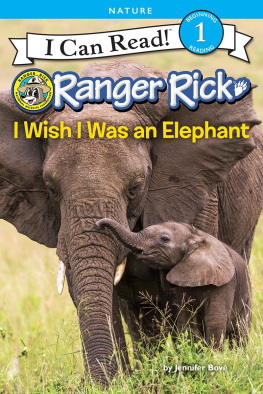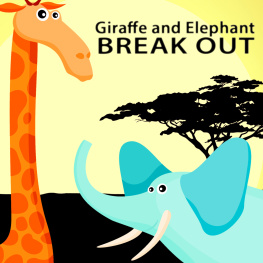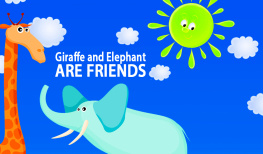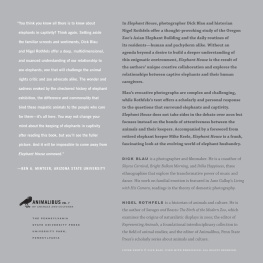THE
COWBOY
AND HIS
ELEPHANT
THE STORY OF
A REMARKABLE FRIENDSHIP
Malcolm MacPherson
THOMAS DUNNE BOOKS
St. Martins Griffin  New York
New York
THOMAS DUNNE BOOKS .
An imprint of St. Martins Press.
THE COWBOY AND HIS ELEPHANT . Copyright 2001 by Malcolm MacPherson. All rights reserved. Printed in the United States of America. No part of this book may be used or reproduced in any manner whatsoever without written permission except in the case of brief quotations embodied in critical articles or reviews. For information, address St. Martins Press, 175 Fifth Avenue, New York, N.Y. 10010.
www.stmartins.com
Book design by Michelle McMillian
Frontispiece and all photographs courtesy of Robert Norris.
Library of Congress Cataloging-in-Publication Data
MacPherson, Malcolm.
The cowboy and his elephant : the story of a remarkable friendship / Malcolm MacPherson.1st St. Martins Griffin edition.
p. cm.
ISBN 0-312-25209-9 (hc)
ISBN 0-312-30406-4 (pbk)
1. African elephantUnited States. 2. Norris, Bob (Robert C.).
I. Title.
QL737.P98M34 2001
599.67'4'0973dc21 | 2001017427 |
[B]
10 9 8 7 6
For the author, this book is dedicated to
Jane Erkenbeck, with love and appreciation
And for Robert Norris, this book is also dedicated to
The Autism Foundation,
My loving wife, Jane,
Our children and grandchildren,
And all animal lovers wherever they might be
Theres right and theres wrong. You get to do one or the other. You do one, and youre living. You do the other, and you may be walking around, but youre as dead as a beaver hat.
JOHN WAYNE
THE
COWBOY
AND HIS
ELEPHANT
PROLOGUE
The elephant that escapes the cull is called the Storyteller. She tells other elephants of the good and evil that men have done to her and her kind, and holds these truths in her heart forever. And in the end, in summing up, her story is taken into account. She is ancient and wise and sublime, and her words weigh heavily in the final ledger.
Elephant hunters in Africa believe this to be true. One old hunter, sitting at a campfire after the sun falls gives voice to his fear. Insistence, awe, and a hint of unease tinge his voice when he recalls, All the years when we went for a herd we said that not one elephant must escape us! If one does, we will follow her the rest of our days. No matter what! She must not be allowed to tell other elephants what she saw. Elephants talk to each other. Yes! We know. We know if from hunting them and we have hunted them forever. Not one must ever get out alive. Listen to me! This is true. The Storyteller is real.
CHAPTER ONE
W hat the old hunter knows is legend. Among all the animals no tighter bond of emotion exists than the one between female elephants, who live with their mothers until they die. Through the ages they have wandered the plains of southern Africa in mother-daughter-grandmother communions. They have lived for and within one another, with no conceivable distinct existence. Indeed, separation condemns them to a living death by the most painful of meanslonging for the herd. Only a special few elephants have ever triumphed over this loss and loneliness. One of them was born in Zimbabwe in the spring of 1988.
_____
A short time before her birth, in the last contractions of labor, her mother had squatted on her hind legs, her sides heaving with the weight of her burden. With a bellow and gargantuan groans and sighs she pushed the infant from her womb neck first, with its head tucked between its long forelegs, somewhat resembling a high diver. The light-gray-colored bundle dropped onto the ground with a soft thud and lay in stillness inside the clear wrapping of the amnion. Other elephants looked on, apparently with intense curiosity.
The mother let out a sigh and a shudder. She extended her trunk and helped her baby escape the sac that had been her world for the twenty-two months since her conception. The infant struggled with an instinctive urgency to steady her own ungainly legs. She slipped in the mud of mixed dirt and amniotic fluid. She raised herself again, but she did not stay upright. Drained by the effort of standing, falling, and falling again, she tried to raise herself one last time. Now her aunties, as elephant researchers sometimes call older females, rushed in to steady her. With their pointed pink trunk fingers they touched her body tenderly.
With that a fanfare of trumpeting, harrumphs, rumbles, and thunderous stomping and dustingaltogether a raucous celebrationfilled the air. The females trumpeted and bellowed, defecated, and ran in shambling circles of pure elephants joy.
Hearing the news from afar, relatives from the herd came around. The bulls stood apart, throwing trunks of powder-dry ocher dust in clouds over their heads and rumbling to one another, curious and aloof. They eyed the teenage females in passing to try to judge their readiness to breed. And soon, as always, they lost interest and went back to sparring with their tusks. They posed, huge and majestic, and challenged one another with playful charges and furious dustings, squabbling over who was better than whom.
The females paid them slight heed. As they fussed over the baby, their displays of genuine caring were as heartwarming as any in nature. The birth brought them great pleasureor whatever elephants feel when theirs is the world in which a baby has been born. This generosity of spirit reflected some deeper, mysterious, and unique emotion that only some few females of the mammalian species can feel. In this female world of such close community, the newborn was theirs, as if she had emerged from their collective elephant-family womb. The baby was their new daughter, granddaughter, cousin, and niece, but to each elephant of childbearing age, as an individual, she was also her baby alone.
And what an arrival she was! Shiny and new, tippy on her feet and nearly blinded by the sharp African light, she peeked out from between her mothers legs and uttered her first cry of Pra-pra, the tiny plaint of a newborn that means Im hungry. Her mother gave a soothing rumble from deep within her, and rich, chalk-colored milk dripped from her nipples.
As a normal and, one might say, beautiful baby, the newborn stood about two and a half feet tall at the shoulders and weighed slightly under 150 pounds. She was battleship gray (bright pink behind her ears), with baggy pink skin bunched at her knees like a child in her grandpas long underwear. The hair on her heada frizzy, wine-colored capgave her a confused, sleepy look, like someone whom the inconvenience of birth had startled out of a delicious dream. Standing in the shadow of her mothers flanks, she explored her own being with a dubious mien.
She swayed her trunk as if it were a deadweight. An irritable look in her sharp brown eyes seemed to say, This whatever it is on the front of my face is a mistake. Please, whoever gave it to me, remove it.











 New York
New York